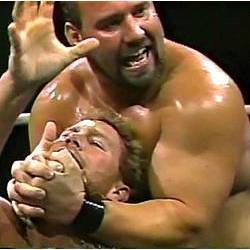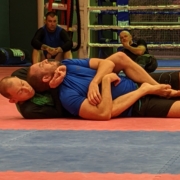Finishing the armbar
“How do I finish the armbar?” This is a common question that beginning students ask. The typical response to this question is “Squeeze your knees together, point your opponent’s thumb away from your chest then raise your hips”. This is fine instruction for a raw beginner. Once the beginner starts to gain more experience, they receive more details “Pull your heels towards your butt, touch your toes together, hug your opponent’s arm to your chest”. Students can easily be left with the idea that to get better at a technique, you must learn more details for that technique.
The problem with this detail oriented approach is that the student doesn’t understand why the armbar works. This means they can’t troubleshoot when it fails. Consider the fight between Georges St. Pierre and Dan Hardy during UFC 111. During the first round, GSP has a tight armbar on Hardy, but Hardy escapes. Why did the armbar fail? What mistake did GSP make that allowed Hardy to escape?

Georges St. Pierre attempts an armbar on Dan Hardy at UFC 111
A detail oriented student will claim the armbar failed because GSP didn’t squeeze his knees together, as this is the obvious detail that is absent. If you do an Internet search you will find many people claiming this to be the reason. This is incorrect. If GSP did squeeze his knees together, Hardy would have escaped even earlier.
To understand why the armbar failed, we must first understand the principles behind the armbar.
The arm is essentially two rods connected with a hinged joint. The goal of the armbar is to hyper-extend this joint beyond its maximum extension, using the strong muscles of the legs and hips. The armbar is achieved by clamping the ends of these rods (shoulder and wrist) in place while the hips push into the joint to hyper-extend it. The obstacle to performing the armbar is that the shoulder can rotate so that the elbow is no longer in line with the force applied by the hips. This rotation removes the hips ability to hyper-extend the elbow.
The principles behind the armbar are:
- Immobilise both the wrist and the shoulder
- Ensure the elbow is in line with the hips
- Raise the hips to hyper-extend the elbow
All the details we know about performing the armbar are to assist with these principles.
If we re-examine the GSP vs Hardy match, we see that initially GSP has immobilised Hardy’s wrist and shoulder. Hardy manages to rotate his elbow to prevent the hyper-extension. GSP changes his grip on the wrist from a tight elbow hook to a double wrist grab. This is the mistake that causes the armbar to fail. GSP would like to rotate Hardy’s hand so the elbow also rotates to become in line with his hips, but he cannot got a good grip due to the gloves. The double wrist grab is not strong enough to immobilise Hardy’s wrist, so it is only a matter of time before Hardy escapes.
Squeezing of the knees would not have solved GSP’s problem. Squeezed knees might have made it slightly more difficult for Hardy to rotate his elbow, but it was the loss of wrist immobilisation that allowed Hardy to escape.
Beginners respond well to a detail oriented approach to learning BJJ. But to move beyond mere competence, student’s require the principles involved so they can understand the purpose behind the details.



Leave a Reply
Want to join the discussion?Feel free to contribute!